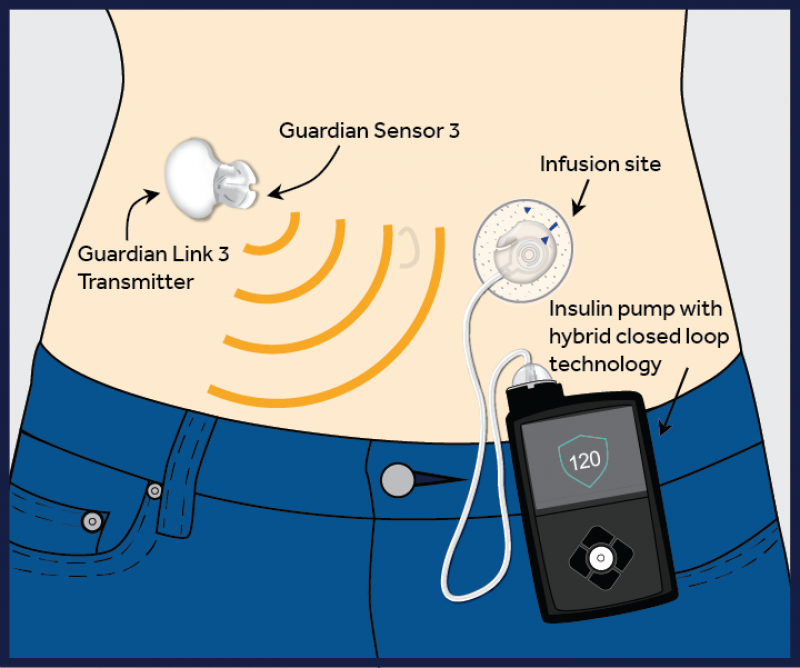Diabetes mellitus, particularly type 1 diabetes, has long been a challenging condition to manage effectively. Constantly fluctuating blood glucose levels require meticulous monitoring and precise insulin administration, making it a demanding and often burdensome task for individuals living with the condition. However, hope shines on the horizon with the development of the Artificial Pancreas Device System (APDS), a groundbreaking technological marvel that promises to revolutionize diabetes management.
At its core, the APDS is a sophisticated closed-loop system that mimics the function of a healthy pancreas. It combines continuous glucose monitoring (CGM) with an insulin pump, operating seamlessly to maintain optimal blood glucose levels without the need for constant intervention from the wearer. The device continuously tracks glucose levels in real-time, feeding this information to the insulin pump, which then delivers precise doses of insulin accordingly.
One of the most remarkable aspects of the APDS is its ability to personalize diabetes management. Each individual's physiology and lifestyle are unique, affecting how their body responds to insulin and glucose fluctuations. With the APDS, users can customize the system to suit their specific needs, resulting in more accurate and efficient diabetes management. This personalized approach not only improves glycemic control but also enhances overall well-being and quality of life for individuals with type 1 diabetes.
One of the critical challenges in diabetes management is preventing hypoglycemia, where blood sugar levels drop dangerously low. Hypoglycemic episodes can lead to seizures, unconsciousness, and, if left untreated, can be life-threatening. The APDS addresses this concern through its continuous glucose monitoring, which can promptly detect even slight decreases in blood glucose levels. The device automatically adjusts insulin delivery to prevent hypoglycemic episodes, thereby providing a safety net for individuals and their loved ones.
On the other end of the spectrum, hyperglycemia, characterized by high blood sugar levels, poses its own set of risks. Prolonged hyperglycemia can lead to long-term complications such as kidney disease, vision problems, and nerve damage. With its ability to continuously monitor glucose levels, the APDS ensures timely insulin adjustments to maintain stable blood sugar levels and reduce the occurrence of hyperglycemic episodes, contributing to better long-term health outcomes.
A significant advantage of the APDS lies in its accessibility to real-time data. Data is an invaluable tool in diabetes management, as it provides insights into glucose trends and how the body responds to various factors. The APDS offers users and healthcare providers access to real-time glucose levels, insulin delivery rates, and other pertinent information through mobile apps and other connected devices. This data empowers individuals to make informed decisions about their diabetes care, leading to more proactive and effective management.
Safety is of paramount importance in any medical device, and the APDS incorporates various safety features to ensure the user's well-being. The system is designed to minimize the risk of insulin over-delivery or under-delivery, preventing potential complications that could arise from inaccuracies in insulin dosing.
Clinical trials have demonstrated the efficacy of the APDS in achieving target glycemic levels and reducing HbA1c values. The positive outcomes observed in these trials have instilled hope in the diabetes community, sparking enthusiasm and anticipation for the widespread adoption of this life-changing technology.
The potential impact of the APDS extends beyond medical benefits. By reducing the incidence of severe hypoglycemia and diabetes-related hospitalizations, this innovative device holds the promise of lightening the economic burden of diabetes on healthcare systems and families alike. Moreover, it paves the way for greater inclusion of individuals with diabetes in sports and exercise activities, promoting overall health and well-being.
Children and adolescents with type 1 diabetes stand to gain significantly from the APDS. The device's user-friendly interface and automated functionalities ease the burden of diabetes management for parents and caregivers, empowering young patients to lead active lives while maintaining better glycemic control.
The APDS also plays a vital role in addressing nighttime glycemic control challenges. Nocturnal glucose management can be particularly difficult, as individuals may be unaware of potentially dangerous fluctuations during sleep. However, the APDS diligently continues to monitor glucose levels and adjusts insulin delivery throughout the night, ensuring that users wake up to stable blood sugar levels.
The compatibility of the APDS with smart devices further enhances its convenience and user experience. With the ability to sync with smartphones, smartwatches, and other tech gadgets, individuals can discreetly access their glucose data and manage their diabetes with ease, regardless of their location or activity.
In conclusion, the Artificial Pancreas Device System represents a transformative leap forward in diabetes management. By providing a closed-loop, personalized approach, the APDS offers hope for improved glycemic control, enhanced safety, and a better quality of life for individuals with type 1 diabetes. As this revolutionary technology continues to evolve and gain acceptance, the future looks brighter for millions of people worldwide, bringing them closer to a world where diabetes no longer stands in the way of living life to the fullest.
